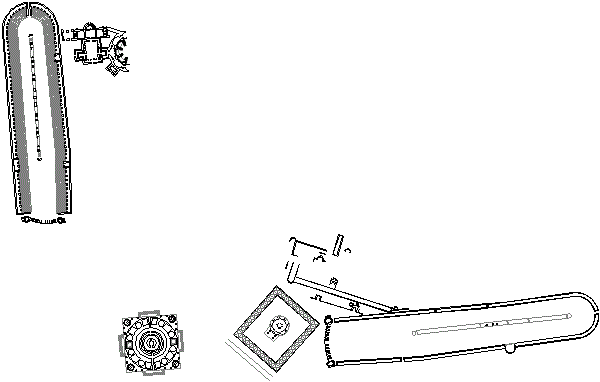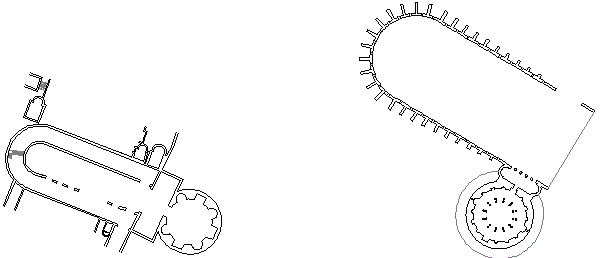7 January: Saint Lucian of Antioch suffers martydom at Nicomedia under the persecution of Maximinus Daia, and receives subsequent burial at Drepanum.
Summer: Constantine begins his campaign against Maxentius with a military force of 40,000 men. The cities of Segusio (Susa), Augusta Taurinorum (Turin), Milan and Verona presented Constantine little resistance on his way to Rome, and subsequently all of northern Italy was on his side.
27 October at night: A dream evokes Constantine to place a sign of Christ upon the shields of his soilders before they enter battle.
28 October: Maxentius offers battle with Constantine outside the gates of Rome near the Milvian Bridge. Maxentius suffers total defeat, himself drowning in the Tiber. Henceforth, Constantine believes in the power of the Christian God.
29 October: Constantine victoriously enters Rome; Constantine stays in Rome until January 313.
312 November Eutropia swore that she had conceived Maxentius in adultery with a Syrian (Origo, 12)
The Roman Senate decrees Constantine senior Augustus, which makes him undisputed master of the western Empire.
end of 312: Constantine founds the Lateran basilica, subsequently called after him the Basilica Constantiniana, has it decorated and endows it with furnishings and landed property.
Helena takes up residence within the palatium Sessorianum at Rome.
| |
Basilica Constantiniana
The Anonymous Valesianus, in his Origo Constantini Imperatoris, relates how Eutropia confessed to Maxentius's illegitimate paternity, i.e., Maxentius was not the son of Maximian. Barnes (The New Empire of Diocletian and Constantine, p. 34) dates Eutropia's confession as early as November 312.
"Meanwhile Constantine after defeating the tyrant's generals at Verona, went on to Rome. When he had reached the city, Maxentius came out and chose a plain above the Tiber as the place to do battle. There the usurper was defeated, and when all his men were put to flight, he was prevented from escaping by the crowd of fugitives, thrown from his horse into the river, and drowned. On the following day his body was recovered from the river, and the head was cut off and taken into Rome. When his mother was questioned about his parentage, she admitted that he was the son of a Syrian. He ruled for six years."
If true, this event may then well be considered the first overt sign that Eutropia was altogether committed to Constantine and his Christian cause. Remember, by this time Constantine, although Eutropia's son-in-law via his marriage to Fausta (apparently the only child of both Eutropia and Maximian), was already also the cause of Maximian's death and Maxentius' death, Eutropia's husband and son respectively. Moreover, the whole notion of confession may also be viewed as indicative of Eutropia's Christian beliefs.
Conversely, Eutropia's admission of Maxentius' illegitimacy could just as well be interpreted as an effort toward survival, not only to secure her own life, but the life of her daughter Fausta as well. That Eutropia was already well positioned within Constantine's good graces, however, may be why Eutropia was able to make the confession in the first place.
In either case, Eutropia's confession works as a savvy political maneuver that, at least symbolically, renders Maxentius' usurpative reign illegitimate as well, thus signaling to those still loyal to Maxentius that, at base, the whole Maxentius event was, in simple terms, a big "mistake". And, in considering the religious implications of Eutropia's confession, they fit perfectly with the Christian "mission" that quickly spread throughout the city of Rome at the exact same time.
As already related, by November 312 Eutropia was an integral part of Constantine's court, and indeed at Rome. It is thus not at all unlikely that Eutropia and Helena knew each other quite well, since Helena too was an integral part of Constantine's court very likely since late 306. Eutropia and Helena may even have known each other since the marriage of Constantine and Fausta in 307.
Eutropia's confession about the father of Maxentius
Meanwhile Constantine after defeating the tyrant's generals at verona, went on to Rome. When he had reached the city, Maxentius came out and chose a plain above the Tiber as the place to do battle. There the usurper was defeated, and when all his men were put to flight, he was prevented from escaping by the crowd of fugitives, thrown from his horse into the river, and drowned. On the following day his body was recovered from the river, and the head was cut off and taken into Rome. When his mother was questioned about his parentage, she admitted that he was the son of a Syrian. He ruled for six years.
Anonymus Valesianus, Origo Constantini Imperatoris.
1999.05.21 19:32
Re: the Agonalia
Tom raises one of the (religious) ambiguities that may always surrounded Constantine. I have read some reference to the popular worship of Mithra (spelling? - an eastern sun cult I believe) during Constantine's time. For example, while Constantine was one of the junior emporers ruling from Trier over Gaul, Britian and Spain, the overall political crises engendered by the usurpative Maxentius in Rome brought together the retired emperors of Diocletian, Maximian (Maxentius' father) and Galarius (eastern Augustus) for a meeting near Vienna. There is some existent inscription relating to that meeting suggesting that offerings to Mithra were made. I don't think that Constantine was at that meeting, however.
My feeling is that both Constantine and Helena were very interested in Chistianity, and perhaps believers, before Constantine's vision in 312. If they were, however, they had to keep it very much to themselves. The retired emperor Maximian, who resided within Constantine's court in Trier (c. 308-311) was an ardent persecutor of the Christians while he co-reigned with Diocletian. One has to look carefully at Constantine's early political position as emperor to see that it was precarious, and professing even a tolerance of Christianity before his position became stable might well have been political, if not literal suicide.
Personally, the more I research this particular history, the more facinating it becomes. For example, check out the uncanny family relations between Constantine and Maximian, and you will realize that none of the Constantine-Helena story is easy.
ps
Constantine "practiced" Christianity as of 312, but was not baptized until a few days before his death in 337. Constantine's remaining an unbaptized Christian for most of his life is precisely the issue that raises all the ambiguity surrounding his "faith".
1999.08.18 17:34
18 August -- the feast of Saint Helena
Was Helena secretly a Christian well before Constantine's conversion the night before the Battle of the Milvian Bridge [12 October 312]?
Did the city and citizens of Rome experience their first true peace once Helena began to live there in 313? Was it indeed an Empress, and not an Emperor, that ultimate delivered Rome's "eternal" peace? [In the thirty years of Constantine's rule as an emperor, the combined time he actually stayed in Rome amounts to less than one year.]
Is it just coincidence that Helena's Palace in Rome was literally right down the street from the tract of land Constantine bestowed upon the Papacy in order for it to establish the first Papal Palace and Rome's (and the world's) first Christian basilica? [Don't we all wish we could choose our neighbors?]
Did the city of Rome simple become Helena's sole domain? [What person with an innate talent for architecture suddenly finding themselves holding absolute power wouldn't make the city of Rome their domain?]
| |
2013.10.28 18:59
28 October
28 October 306: the Senate and the Praetorian Guard in Rome proclaim Maxentius as emperor princeps.
It could easily be said that the architecture of Rome (the city) under Maxentius represents the last flourish of genuine Classical in its true pagan milieu.

left: The Circus of Hadrian and the Mausoleum of Hadrian (135 AD), after Piranesi.
right: The Circus of Maxentius and the Mausoleum of Romulus (son of Maxentius) (c. 310 AD), on the Appian Way.
Both complexes, displayed here at the same scale with true north up, comprise the 'classic' Roman funereal paradigm of tomb, circus and dining hall, facilitating the "munus", a death rite, where death games and feasts accompanied the funeral day.
28 October 312: Maxentius offers battle with Constantine outside the gates of Rome near the Milvian Bridge. Maxentius suffers total defeat, himself drowning in the Tiber.
It is at this point that the architecture of Rome (the city) begins to represent a pagan/Christian hybrid, with stylistic influence coming from the North (Treves Augustum [today's Trier, Germany]), Constantine's Imperial capital, and from the East (Nicomedia [today's Izmet, Turkey]), the Roman Empire's power center since c. 280 AD.

left: The Circus of Maxentius and the Mausoleum of Romulus (son of Maxentius) (c. 310 AD), on the Appian Way.
center: The 'basilica' of Sts. Peter and Marcellinus (c. 314 AD) and the Mausoleum of Helena (mother of Constantine) (326 AD).
right: The 'basilica' of St. Agnes (c. 314 AD) and the Mausoleum of Constantina (daughter of Constantine) (c. 345 AD).
The three complexes, displayed here at the same scale with true north up, demonstrate how the tombs remained more or less the same, i.e., substantial round, domed structures, but the pagan funereal circus has morphed into a circus-shaped covered graveyard where feasts were held on the respective saint's death ('feast') day.

It is on record that the yearly commemorative feasts of saintly death days quickly evolved into quite exorbitant, if not all out drunken, several-day-long affairs, thus, by the beginning of the fifth century, Rome's somewhat unique circus-shaped basilica/graveyards were deemed inappropriate for 'church' architecture, closely coinciding with (St.) Augustine's writing of The City of God Against the Pagans.
|